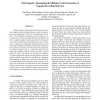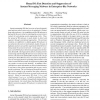57 search results - page 2 / 12 » A semantics-based approach to malware detection |
ACSAC
2006
IEEE
13 years 10 months ago
2006
IEEE
Modern malware often hide the malicious portion of their program code by making it appear as data at compiletime and transforming it back into executable code at runtime. This obf...
ICC
2009
IEEE
13 years 2 months ago
2009
IEEE
Smartphones are getting increasingly popular and several malwares appeared targeting these devices. General countermeasures to smartphone malwares are currently limited to signatur...
ACSAC
2007
IEEE
13 years 11 months ago
2007
IEEE
Instant messaging (IM) has been one of most frequently used malware attack vectors due to its popularity. Distinct from other malware, it is straightforward for IM malware to fin...
TACAS
2012
Springer
12 years 9 days ago
2012
Springer
The number of malware is growing extraordinarily fast. Therefore, it is important to have efficient malware detectors. Malware writers try to obfuscate their code by different tec...
CCS
2008
ACM
13 years 6 months ago
2008
ACM
Malware has become the centerpiece of most security threats on the Internet. Malware analysis is an essential technology that extracts the runtime behavior of malware, and supplie...


